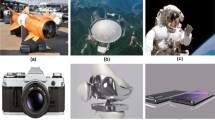Abstract
Ballonet polishing tools, soft gasbags filled with compressed gas, have already been one of the most reliable tools in curved surface polishing due to their adaptability to change their shape to fit the worked surfaces with the same contact stress everywhere. When the internal pressure of the gasbag is adjusted on-line, the contact stress could be controlled as you want. But, because of the tensile stress of the gasbag's material, the internal pressure could not identify the real contact condition anymore. In this paper, the contact force is used to identify the real contact condition for workpieces of aspheric surfaces which is indispensable to the polishing process control. Based on the measured internal pressure of the gasbag and the on-line-controlled contact force in the normal direction, this paper studies the arithmetic of the contact area for aspheric surfaces, finds a way to eliminate the great difference of machining speed, and advances an arithmetic of the machining time for material removal controlling in the process of aspheric surface ballonet polishing. A real ballonet polishing system is developed for aspheric surfaces, and experiments show that it is a better way by controlling the contact force rather than by controlling the internal pressure in the process of aspheric surface ballonet polishing.
Similar content being viewed by others
References
Agbaraji C, Raman S (2009) Basic observations in the flat lapping of aluminum and steels using standard abrasives. Int J Adv Manuf Technol 44(3–4):293–305
Jeong S, Lee S, Park B, Kim H, Kim S, Jeong H (2010) Mechanical effects of polishing pad in copper electrochemical mechanical deposition for planarization. Curr Appl Phys 10(1):299–304
Bibik EE (2010) Mechanochemistry of metal polishing with an abrasive suspension. Russ J Appl Chem 83:811–815
Mirian SS, Fadaei A, Safavi SM, Farzin M, Salimi M (2011) Improving the quality of surface in the polishing process with the magnetic abrasive powder polishing using a high-frequency induction heating source on CNC table. Int J Adv Manuf Technol 55(5–8):601–610
Klocke F, Brecher C, Zunke R, Tuecks R (2008) Finishing complex surfaces with zonal polishing tools. Manuf Syst Technol New Front 12:445–448
Liao L, Xi FF, Liu KF (2008) Modeling and control of automated polishing/deburring process using a dual-purpose compliant toolhead. Int J Mach Tool Manuf 48(12–13):1454–1463
Zhong ZW, Tian YB, Ang YJ, Wu H (2012) Optimization of the chemical mechanical polishing process for optical silicon substrates. Int J Adv Manuf Technol 60(9–12):1197–1206
Lee H, Kim J, Kang HY (2010) Airbag tool polishing for aspherical glass lens molds. J Mech Sci Technol 24:153–158
Zhang W, Li HY, Jin H (2009) Research on digital simulation and experiment of removal function of ballonet tool polishing. J Mech Eng 45(2):308–312
Zhao J, Zhan JM, Jin RC, Tao MZ (2000) An oblique ultrasonic polishing method by robot for free-form surfaces. Int J Mach Tools Manuf 40(6):795–808
Rahman MS, Saleh T, Lim HS, Son SM, Rahman M (2008) Development of an on-machine profile measurement system in ELID grinding for machining aspheric surface with software compensation. Int J Mach Tool Manuf 48(7–8):887–895
Liu YT, Chang WC, Yamagata Y (2010) A study on optimal compensation cutting for an aspheric surface using the Taguchi method. CIRP Journal of Manufacturing Science and Technology 3:40–48
Lee ES, Baek SY (2007) A study on optimum grinding factors for aspheric convex surface micro-lens using design of experiments. Int J Mach Tool Manuf 47(3–4):509–520
Pan CT, Wu TT, Liu YT, Yamagata Y, Huang JC (2009) Fabrication of aspheric surface using ultraprecision cutting and BMG molding. J Mater Process Technol 209(11):5014–5023
Zhan JM, Yu SH (2011) A new aspheric surfaces polishing by parallel orthogonality movement/force servomechanism. J Manuf Sci Eng 133(3):031011
Zhan JM, Yu SH (2010) Study on error compensation of machining force in aspheric surfaces polishing by profile-adaptive hybrid movement-force control. Int J Adv Manuf Technol 54(9–12):879–885
Shi YJ, Zheng D, Hu LY, Wang YQ, Wang LS (2012) NC polishing of aspheric surfaces under control of constant pressure using a magnetorheological torque servo. Int J Adv Manuf Technol 58(9–12):1061–1073
Evans CJ, Paul E, Dornfeld D, Lucca DA, Byrne G, Tricard M, Klocke F, Dambon O, Mullany BA (2003) Material removal mechanisms in lapping and polishing. CIRP Ann Manuf Technol 52(2):611–633
Xi FF, Zhou D (2005) Modeling surface roughness in the stone polishing process. Int J Mach Tool Manuf 45(4–5):365–372
Schinhaerl M, Smith G, Stamp R, Rascher R, Smith L, Pitschke E, Sperber P, Geiss A (2008) Mathematical modelling of influence functions in computer-controlled polishing: part I. Appl Math Model 32(12):2888–2906
Ahn JH, Lee MC, Jeong HD, Kim SR, Cho KK (2002) Intelligently automated polishing for high quality surface formation of sculptured die. J Mater Process Technol 130–13:339–344
Chen FJ, Yin SH (2010) Profile error compensation in ultra-precision grinding of aspheric surfaces with on-machine measurement. Int J Mach Tool Manuf 50(5):480–486
Lee MC, Go SJ, Lee MH, Jun CS, Kim DS, Cha KD, Ahn JH (2001) A robust trajectory tracking control of a polishing robot system based on CAM data. Robot Comput Integr Manuf 17(1–2):177–183
Karayiannidis Y, Rovithakis G, Doulgeri Z (2007) Force/position tracking for a robotic manipulator in compliant contact with a surface using neuro-adaptive control. Automatica 43(7):1281–1288
Suzuki H, Moriwaki T, Okino T, Ando Y (2006) Development of ultrasonic vibration assisted polishing machine for micro aspheric die and mold. CIRP Ann Manuf Technol 55(1):385–388
Author information
Authors and Affiliations
Corresponding author
Rights and permissions
About this article
Cite this article
Zhan, J. Study on the manufacturing process controlling for aspheric surface ballonet polishing. Int J Adv Manuf Technol 69, 171–179 (2013). https://doi.org/10.1007/s00170-013-5009-7
Received:
Accepted:
Published:
Issue Date:
DOI: https://doi.org/10.1007/s00170-013-5009-7



